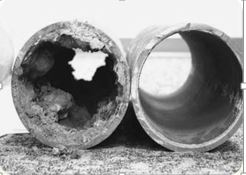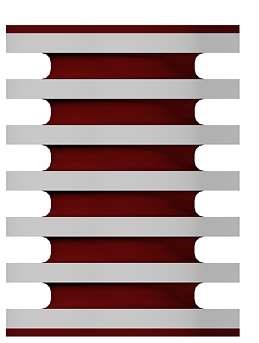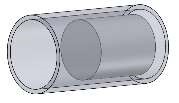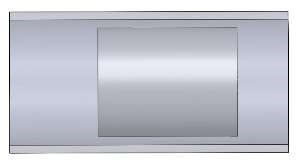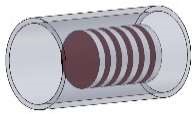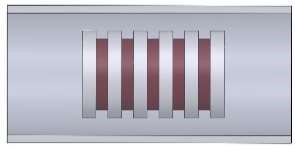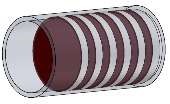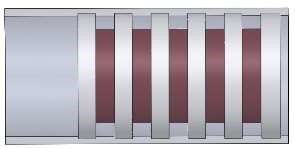1- Definition, such as what is pig and what is pigging operation.
Pigging can be defined as the action of making a device travel in inside a line of pipes to perform a specific job. Pigging comes from the word PIG, which is used to give a name to these internal devices. PIG is defined as Pipeline Internal Gauging (Internal Line Calibrator), which relates these devices to several works that are done inside the lines.
The Pigs are devices that are inserted and traveled along the length of a pipeline, driven by the flow of the same. There are two categories: Polly Pigs and Pigs which are elements of basic cleaning its main function is to clean and remove sediment inside the pipe to go.

-
- Pig Seal Bi-Direccional 1.2 Polly Pig Seal Bi-Direccional
The second category relates to hell or pigs or smart instrumented which provide information on the status of the line, as well as the extent and location of any problem or abnormality in the same
Pig systems are used to empty and clean pipes making the most of the product and saving product residual. The scraper or pig, acts like a brush and is pushed by a propellant product (air, N2, etc.) or a liquid, moving along the entire pipeline and scrupulously cleaning their Interior walls.
The cost of removing waste or residues in the process lines is one of the most important costs. The majorities of the process plants try to perform internal cleaning, after the completion of a certain process, through the circulation of water or chemicals.
The use of these methods results in the cleaning is not totally effective because most of the time a water & product interface remains that cannot be completely removed from the inside of the lines. To this is added, the expense incurred both in the use of water or chemical products used for cleaning.
Performing cleaning using “pigs”, after a complete cycle is complete, allowing complete removal of the remaining product. Also in the event that additional cleaning with water or chemical products is necessary for complete sterilization. The later use of the “pigs” ensures a total removal of these.
In those cases, a large variety of products are used in the same process lines. Removal systems products “pigs” significantly reduce downtime cleaning, thereby reducing operating costs.
The separation of products through the use of “pigs” is another very important application to be mentioned. In those processes that for different reasons (quantity of products pumped in relation to the diameter and length of the line) it is necessary to separate two compatible products. With the use of “pig”, it is perfectly feasible, and in the same line, these products are transferred at the same time.
The correct design of the systems of the pipes, suitable for the circulation of “pigs”, can replace multiple lines of process. Ensuring a good quality of the products with high productivity.
The “pigs” is a cylindrical element, of a single body, smooth or with a certain outer covering. Existing models of different configurations. These can be constructed with a series of seal rings or scrapers or pushers that produce the removal and/or cleaning of the lines. They are built in non-degradable materials that react with the transferred product. They are not toxic, absorbent, and resistant to most cleaning chemicals.
These are flexible, bidirectional, and reusable. They can be built in different materials, such as Urethane, polyethylene, Buna N, Viton and EPDM, Neoptrene, etc.
They are specially formulated to be used in the food, pharmaceutical, cosmetic, and beverage industries. They are approved by the FDA standards for sanitary service.
Models are available, for those cases where they are used for the removal of chemical products, such as lubricating oils, oil, water, etc.
They allow its passage through elbows with a long radius (1.5 D), ball valves with a total pitch, and elbows of 45 gr.
Benefits of Pigging Process
- The pig system allows reducing of pipeline costs and accessories.
- Possibility of vehicular different products without effects of pollution or mixture between them.
- Increase in production availability.
- No need to rinse or only in small quantities with consequently saving time and money
- Heat-proofing is not necessary in order to completely empty the product line.
- Reduction of water or residual product as a consequence of cleaning.
- Possibility of total follow-up during the procedures of transfer and cleaning.
Industrial sectors of application
- The pigs system is especially recommended in cases in which several products must be transported by the same pipe.
- In cases of need for total emptying of pipes, even with high viscosity products
- For pipe cleaning
- When small quantities of the product should be dragged by a pipe
- To avoid solidifying cations of products inside the pipelines
- The pig system prevents the formation of foam or bubbles during the transfer of the product.
History of the Duct Cleaning
The History of the Pigs is always interesting. It is always stimulating to at least listen to what the world of the corridors of Hell recognizes the origin and how it originated this peculiar name. The first operation of Pigging is said to pass around the year 1870, a few years after that Colonel Drake discovered oil in Titusville, Pennsylvania.
Before that will be used for the transport lines, the crude oil was transported to refineries in carts pulled by horses. This was of course very difficult particularly during the winter months due to heavy snowfalls and ice formed on the roads, and also to the mud in the rainy season. To simplify the above was built a very rudimentary line was. After a year of the transport of crude oil, of course, they began to notice a decrease in the amount of crude oil transported and an increase in the pressure of the pumps which clearly indicated that there were strong deposits on the inside of the pipe. Tried many things to improve this situation. It was thought at that time on a pile of rags tied in the form of a ball, and this gave positive results, although modest. After the piles of rags were replaced by leather straps made also ball. The leather when wet. Be Beefed up causing a tighter seal in the tube and thus doing a better service.
Also sounds reasonable to think that at that time were pipes of small diameters in the range of 4″-6″. It is also unlikely that they will be called Pigs as it is now known. At that time it was used the term “Go-Pig” or Pig, and perhaps there was derived the term “Pig” used by us.
It is said also trying to explain why they are called pigs or pigs, that the tool to run through the pipes fitted with metal discs and scrapers, they emit a noise or squeal as a pig stuck”, we can also imagine the “poor Pig” when exiting a run completely covered in mud and paraffin, must have seemed a real pig (dirty)
The mere fact of calling him Pig or “Pig” which does not cease to be a term somewhat disparaging or perhaps curious, at least in those times was not taken very seriously in this type of tool, and much less as a piece of engineering. Of course, things have changed a lot and in dramatic ways by others. The Pigs instruments of today, use cutting-edge technologies, and still we would like them to do many more things.
The firsts years
Surely it did not take too long for the operators of those years to realize that a Pig or pig built with discs and scrapers worked more effectively than that ball made of rags, although barbed wire was entangled to scrape better. Thus, Pigs manufactured on purpose worked better as the lines became longer and larger in diameters.
In those years the gas collection systems and the corresponding condensation problems needed something that, instead of scraping, dragged the condensate through the different circuits, from these specific requirements a new era begins for the development of new tools.
When AMF Tuboscope ran the first commercially viable instrumented Pig in 1965, it ushered in a new era for the Pig industry. From that moment it became necessary to clearly mark the difference between a conventional Pig used for cleaning and an instrumented Pig used to collect information.
The AML Pig Linalog is used to detect corrosion and after a short time, TD Williamson announced if Pig kaliper to detect bumps, wrinkles and other diameter reductions. Both the Pig Linalog and Kaliper went through a long process of development before its introduction. Now with almost 35 years of further development and experience, they have new technologies.
In recent years there has been a dramatic increase in the number of instrumented Pigs and available services. The less there are eight different types of Pigs for loss of metal/corrosion, five of geometry, and many others such as crack detection. Inspection (video/photography), curvatures, leaks, measurement of paraffin deposits, sampling, etc
2-The objectives of why it is important to do pigging for the pipelines.
This system consists of sending a torpedo inside the pipe to recover the residual content of the product. At the end of each production, you lose all the product that has been on the line. This volume of product, can be recovered and used thanks to the pigging system again.
Example:
DN 50: 2 liters per, DN 80: 5 liters per, DN 100: 8 liters per, DN150: 18 liters per, DN 300: 80 liters per
Why Run Pigs?
Among the main advantages that we can mention are:
- Reduces line cleaning times
- Reduce pollution
- Reduces the expenses of chemical products for cleaning.
- Reduce the loss of products
- Reduces the need for multiple lines for specific products.
- Reduce costs by testing and testing laboratories.
Protect assets and Optimize Efficiency
Sometimes we resort to the Pigs runs when a problem is too apparent, and there is no other alternative, of course when this point is reached, most of the time it is too late, and the damage can be large. The use of suitable Pigs in accordance with the application of the appropriate programs will always manage to maintain the integrity of the line and in optimum conditions of efficiency. Obtain the Design Flow with the minimum capital investment and with the lowest operating costs. Not only is it important to design and build a line based on continuous operation and optimal efficiency, but we must always keep it that way, the Pigs play a role of paramount importance in fulfilling it.
The pigging system improvement:
Environment
Being the empty line of product, after the passage of the torpedo, it significantly reduces the amount of water and cleaning products. This also allows you to reduce the discharges as the costs of these continue to increase. In addition, the cleaning will be much faster, which will increase the productivity of the line.
Optimization of the lines
in the majority of cases, a line is used only for a single product due to problems of incompatibility. Thanks to the pigging system, a line may transfer different products without having to be compatible.
Example:
A single line for different colors of paint.
A single line for different types of wine.
• Etc…
Reducing the time of immobilization of the lines.
A pigging system may be the ideal tool for a project SMED (Single Minute Exchange of Die). In fact, serial changes can be reduced considerably by reducing or even eliminating the cleaning cycles between2 two productions.
Short-term amortization and increased productivity. Accumulating all the benefits obtained by the pigging system, we can repay it very quickly.
Before v/s After Pigging Process
3- Pigging Theories.
4- Procedures of the pigging operation at the launcher and receiver pipelines.
The increase in productivity has historically been one of the main reasons why the process industries use pigging systems for the internal cleaning of their pipes, and removal, and separation of products.
When a batch of product has been transferred, by pipes, from a storage tank to another section of the plant. Usually, residues remain in these that the impulse pumps have not been able to displace. Although the lines have a certain slope, neither can gravity ensure that the entire product has been moved. The more viscous the product, the greater the residue in the lines.
By introducing “pigs” inside these, the result is that the waste from the processes was pushed towards a final destination (tank or other process section). The recovered products can be commercialized and stop being a waste when these practices are carried out.
The realization of the pigging system results in an increase in productivity by avoiding losses due to contamination or unusable waste.
Through the systems of “pigging,” FLOUSA SA solves its problems related to the removal of products, cleaning of pipes, and separation of products for the process industry.
FLOUSA SA provides the initial technical advice service, verification of suitable installations (pipes and fittings installed, valves, instruments, etc.) as well as the supply of “pigs,” launching devices & reception, and passenger detectors, etc..
The “pigs” are installed in the lines, by means of launching stations. By means of these, the “pigs” are introduced in the line and allow the impulsion of these to the process lines. The drive from these launching stations can be carried out under pressure (ie without stopping the normal process of operation of the line) or without pressure (ie with the process line out of service). Usually, the last of the systems is the most used in process lines. In other words, with the process line out of service, the product cleaning or removal process is carried out using the “pigging system.”
These launching stations are designed in such a way that the introduction of the pig has been carried out with ease and that the position of the “pig” in it has been optimized in order for a correct impulsion through the pressure inlet connection.
The correct design of these traps must be such that they have their corresponding connections of taking of pressure, drainage & emptying, and entry of pressure for impulsion. As well as, in the case of requesting it, the “pig” locator in the trap.
On the other hand, at the opposite end, the pig reception stations must be considered in order to receive them. The process connections are similar to those indicated in the pitching traps.
Passage detectors of “pigs” are instruments used for detecting the passage of “pigs.” They are usually non-intrusive instruments, which are fixed to the body of the pipe by a plastic clamp. These instruments detect a magnetic field created by a magnet that is introduced inside the “pig”. The installation of these allows knowing the launch, reception, location, and knowledge of the passage of the “pig” for a certain place.
These instruments have a light signal (indicating the “pig” step) as well as a dry contact switch that can be used to provide a digital input to a control system, operate a sound system of a siren, or energize a signal luminance of a control panel.
System of 1 only pig
The pig is introduced at the start station. After that the transfer of the product has been completed, the pig is thrown out. A propeller product helps push the pig, which moves the product through the pipe. When the pig arrives at the receiving station can be removed from the installation or sent again to the start station.
2 pigs system with cleaning camera
The two pigs are introduced at the start station. After the transfer of the product has been completed, the pipe is cleaned with the two pigs. A cleaning agent is introduced in the start station between the two pigs. The product is emptied of the pipe. When the first pig arrives at the receiving station, the liquid
Cleaning can be changed. Another option may be to send the two pigs back to the start station transporting the cleaning liquid between them. The cleaning product dirty can then be extracted at the start station.
System of 2 pigs as product shutter
The two pigs are introduced in the start station, the first pig is sent until the first diversion along with the product. There the pig serves as a shutter and the product. It can be emptied into the destination deposit. After that the transfer process has completed, the second pig is thrown towards the deviation by means of a propellant product. The pipe is emptied of product. Both pigs return to the start station.
Stages of Use
The first Pigs were used to remove deposits of paraffin or accumulated garbage inside and restore and maintain the flow it today, it is required to run pigs in each phase of the life of the line, and the reasons are:
- During Construction
- Remove construction waste from inside the line.
- Acceptance tests (filling and emptying of water)
- Delivery (Start-up)
- During Operation
- Condensate removal
- Product separation (Bacheo)
- Application of inhibitors
- For Inspection
- Verify physical damage (Geometry) * Instrumented
- Detect corrosion, laminations or cracks * Instrumented
- Sampling
- General Maintenance and Repair. Cleaning before the Pig is instrumented.
- Emptying
- Packing
- Repair / Rehabilitation
- Application of coatings.
- Chemical cleaning
- Rust removal
Consideration
When considering any of the applications indicated above, do not forget that each line is different and we could say that each line has different characteristics such as different diameter, length, contents, geometry, operate under different conditions of temperature and pressure, varies the thickness and very likely its operation is governed by different guidelines.
The foregoing indicates that the selection of pig-run programs, as well as the selection of pigs, should be planned for a particular case taking into account the particular needs and operating characteristics of each line.
Building
Pig runs are an integral part of the construction stage of a pipeline. the first application is when the contractor runs a cleaning pig in short sections of the line to eliminate garbage that always remains when welding the sections of the pipe. The type of pig that must be used will depend on several factors associated with the line, such as diameter, length, terrain topography, and whether it is offshore or terrestrial, and sandy, rocky terrain conditions. However, the work of a construction pig is always heavy and unless the line is internally coated, brushes should be used. Do not forget that normally more than one run is required to do a good job.
Maintenance
General maintenance runs are often not taken with the seriousness that should be taken into account that this is of vital importance since with this we guarantee to maintain our flow and we could maintain in these consistent conditions throughout the life of our line. The main objectives of these maintenance runs are for the removal of paraffin, oxide powders, and water elimination due to condensation; other applications for these runs are the separation between products in the same line and application of corrosion inhibitors.
Industrial plants
In cleaning runs in industrial plants, the principles are not different from those that govern any running operation. However, there are some points that need to be highlighted.
The industrial plants do not normally have launching devices or Pigs receipts. The pipes are not designed to run pigs, and there are often physical impediments to carrying out the runs.
Types of Pigs
- Cleaning: For removal of accumulated solids
1.5 Model LP-UPC-XX 1.6 Model LP-HH -XX 1.7 Model LP-MX –XX
B) Sealing: For removal of accumulated liquids, separation of products, filling and emptying of line
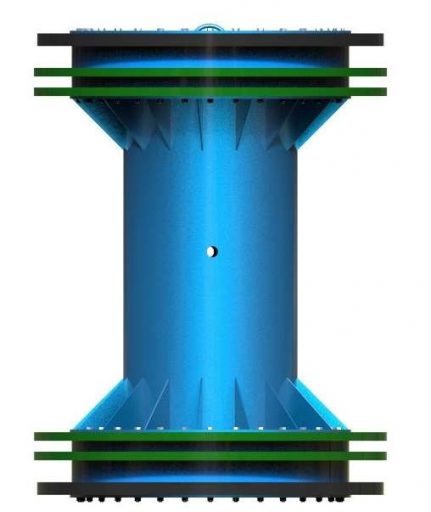
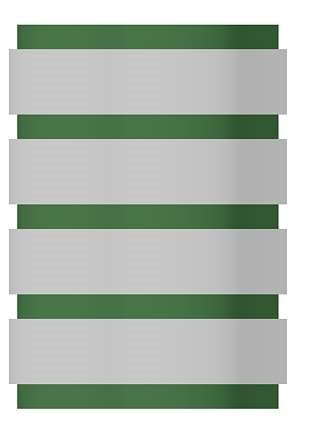
1.8 Modelo LP-BD6 -XX 1.9 Modelo LP-US -XX 1.10 Modelo LP-DP -XX
C) Drying: For removal and absorption of accumulated liquids, to achieve the required Spray Point.
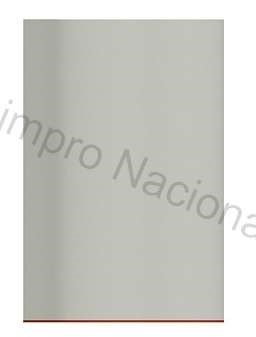
Model LP-LB -XX
The Importance of Maintenance
The pipeline requires a maintenance plan where the repair cost is not comparable to the low cost of maintaining a cleaning program which has the following advantages: easy, low cost, and effective in maintaining the flow of the product. This without taking into account that the good choice and the good operating procedure in the runs of pigs make this method the most feasible and thereby extend the life of any line
Reference Table
| Residue | |||||
| Type of Pig | Sand | Lamination | Powder | Paraffin | Water |
| Sponge (Low Density) | Regular | Bad | Bad | Bad | Regular |
| Polly Pig (Medium and High Density) | Good | Bad | Regular | Bad | Regular |
| Polly Pig and DiabloBidirectional (LP-DP and LP-BD6) | Good | Good | Good | Regular | Excellent |
| Polly Pig Raspador (LP-MW Y LP-HW) | Bad | Regular | Regular | Excellent | Bad |
| Polly Pig and Diablo Bidirectional (LP-DP and LP-BD6) | Bad | Good | Excellent | Bad | Bad |
| Sphere | Bad | Bad | Regular | Bad | Regular |
Reference table based on The waste that can present a line and the performance of each type of Pig
Conditions to Consider
Operating conditions
The product transported in the line undoubtedly plays a very important role in selecting the pig to be used. If the product is food or pharmaceutical, this can influence the design of the Pig. If the Pigs are to be reused, the product affects the decisions to this aspect. The Polly Pigs, because they are cellular in nature, absorb the product and it is almost impossible to clean them. If the product is flammable or of an annoying smell.
Pressure
Most utility pigs are made of materials normally considered solid and therefore the pressure does not affect them. The Pigs Polly Pigs are made of cellular polyurethane, and therefore, the pressure does not affect them Instrumented Pigs, however, have compartments where they house the instruments and therefore have stamps that have to be compatible with the product handled. These Pigs are designed to withstand the pressure of the work of the bullfights.
There are manufacturers that specify minimum operating pressure. This limitation is usually applied for runs with gas or air. When a Pig runs in low gas pressure, it can be stopped frequently due to minor obstructions (ovality, curves or welds) In this case, the pressure increases until it can overcome the obstacle and then accelerates instantly, reaching a very high speed until the energy dissipates or find another obstacle. This can be dangerous and should be avoided
Sometimes it is used to pressurize the line and run the Pig by venting to the atmosphere at the end of the line but keeping a cushion of air in front to avoid accidents
Temperature
The polyurethane elements can be used between 0 and 82 ° C, which does not represent a danger in the vast majority of cases. It must be remembered that polyurethane is hydrolyzed and, therefore should not be stored under humid conditions at temperatures close to 60 ° C. Naturally, there are alternatives for special cases.
Flow rate
The majority of the operations of cleaning, displacement, patching, etc are carried out with the line in service and therefore at the speed of the product on the line. The work of the Pigs is more effective when traveling at a constant speed and not when traveling in a regime of constant starts and stoppages. Neither work is very effective at very high speeds. However, in the construction stage, this factor is not very controllable, and the effectiveness varies.
If the differential pressure is excessive, this will clearly cause excessive wear, especially in a dry or abrasive environment. The speed in the gas line is not very constant. “Unstable speed profile” Rapid acceleration, followed by high speeds and sudden stops since the gas is a comprehensible fluid Mass-spring-damper. The speed control is essential to guarantee the performance of the cleaning elements
For reference purposes only, the following typical values are given
| Application Speed | (Km / hr) |
| Construction | 5–8 |
| Gas | 8–20 |
| Liquids | 3—15 |
These are reference figures and should be used with caution to avoid deterioration of materials, particularly in dry gas with high velocity can occur overheating and hysteresis. It is important to note that as the speed increases, the differential pressure decreases, and since it is the differential pressure that forces the seals against the wall of the tube to do an effective job, it is only logical to think that high speeds do not yield optimal effectiveness.
In the case of instrumented Pigs they need to move at a controlled speed. This is due to the limitations imposed by the data collection and processing thereof. In most cases, the speed is 3-12 km/hr. This range is also highly recommended for utilitarian Pigs.
Progressive Cleaning
The term is used to describe the process of running a battery of pigs that increases progressively, starting with low densities, followed by medium densities and/or an increase in the diameters of cleaning tools and with the main purpose of eliminating deposits in the length of a pipe.
Data to consider during
- Product (Crude, natural gas, refined products)
- Crowns, valves, tees, diameter, length, and product transported
- Launchers and receivers, manometers, valves
Take into account that this is a guide and each pipeline is different in mechanical and operational conditions.
Progressive Cleaning Program Table
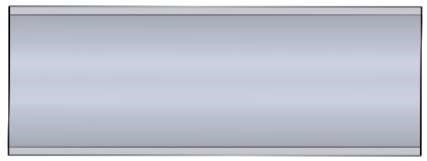 1 1
|
Flow test It is the difference between the input volume with respect to the volume of output and gives an idea of the degree of obstruction |
| 2
|
Test Pig (Inspection) Its function is to determine the size and quantity of cleaning elements to be used
|
| 3
|
1st Run The function is to remove the obstruction gradually increasing progressively diameters of the elements as well as densities |
| 4
|
Last Corrida A sweep is carried out with a cleaning element corresponding to the diameter of the line and the final inspection of 0 residues is carried out. |
5 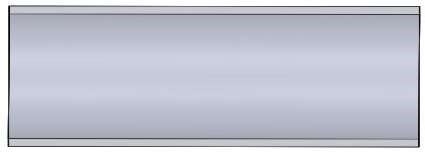 |
Final Flow Test Comparison of pressures and flows before and after the runs as well as the Design Flow. |
Pigging:
An aseptic product recovery system allows you to recover high-cost products by extracting them from the product lines. The special projectile (Pig), powered by compressed sterile air, expels the product from the tube. The residual film inside the product line can be removed with the CIP cleaning system. This technology considerably reduces the pollution of wastewater and cleaning costs, for example, the costs of water and detergents.
Areas of use
- Extraction of pumpable products from product lines
- Complete integration in automation systems
- Calibrated hoses
- Existing tubes with minimum elbow diameters of 1.5 xd
- Sterilization up to 140 ° C
Advantage
- Aseptic product recovery system (Pigging)
- The product circulates around the projectile during production, CIP cleaning and sterilization.
- The product recovery stations are fully integrated into the product line
- Product recovery by purging the line with the projectile
- Production inactivity interval only during the necessary cleaning time
- Lower cleaning costs
- Less pollution of wastewater
- Easy maintenance
- It can be supplied as a unit with a control system
- It can be supplied with an integrated sterile air system (sterile filter)
The current costs in the industry demand systems of fluid conduction with high yields, less friction, and greater cleanliness in the productive processes. The deterioration due to obstruction of the fluid transport lines such as gas pipelines, drainage pipes, or water supply requires internal maintenance through cleaning by “pigs” or “Pigging. This procedure is carried out by introducing a bullet or pig, which internally scratches the walls of the pipes and drags any material that adheres to the internal surfaces or is deposited. That is, an internal sweep is made, achieving the cleaning levels required by each process.
As a strategy to be a supplier of wide gamma of industrial cleaning services, Venefilter took on the challenge in 2012 to present its pipe cleaning services by Pigging (Pigs). The technique applied to internally clean pipes with diameters ranging from 2 “to 36”. The removal of incrustations, oxides, slag from welding processes, etc., is achieved.
They are applied to gas pipelines, pipelines, potable water distribution systems, wastewater, heat transfer lines, among others, and where stretches of lengths from 6 meters to hundreds of kilometers are presented. We comply with ASTM standards.
Main problems
- Non-Piggable Pipes.
- Do not have shipping and receipt traps.
- Reduced port valves.
- Unions greater than 10 ° (Together).
- Wrongly installed bypass connectors (Tees-Y).
- Diameter changes greater than 2 in.
- Low pressures and low operational flows.
The two main reasons are due to problems in valves and radii of curvatures for which several solutions are available
Reasons that cause pigs to stuck in pipelines
- Not important in mechanical constraints (tees, elbows, type of valves
- etc)
- Incorrect size in cleaning elements (disc-cups) III. Valves do not have free passage
- Insufficient information (field curves, thickness changes)
- Run two cleaning tools without enough space between them VI. High friction
- VII. Insufficient stamp
- VIII. Nose under tool on its front
- IX. Accessories wrongly distributed X. Low running speed
- XI. Possible mechanical failure of duct (ovality, dent, transverse rods, grids)
Mechanical Restrictions
Elbows, Curves and Changes of Address
Elbows with a relatively short radius of curvature must be from the factory and are usually forged at different standard radii. The radius of the elbows is measured to its center line. The smallest radius is called 1D of curvature also known as short radius elbow, this means that the radius of curvature is equivalent to the nominal diameter of the pipe, other denominations are 1.5D and 3D which are considered elbows of long radii.
From the point of view of bullfighting, you should avoid the 1D elbows and for 1.5D elbows the most advisable is to run spherical Pigs.
The general recommendations for elbows are the following:
- 10 D for 4in and under
- 5D for 6in-12in
- 3D for 12-Seniors
When ordering Pigs, it is necessary to note these details such as the type of elbows and their inner diameter.
Field curves
It is natural that, in the process of laying a line, the pipeline has to bend to follow the accidents of the land through which it passes. This type of curves in some parts are called cold curves and are formed with bending machines
If a bending machine is not used, it is possible that there is no uniformity in the radios and highlight in a series of artists that could make it unacceptable to run Pigs. It is therefore important that these curves are of uniform radius, do not have flat parts or other deformations. For bullfighting it is recommended that these deformations do not exceed 2 or 3% of the diameter of the tube.
Mitrados elbows
The mitred elbows are manufactured by cutting the tube at a certain angle to achieve the desired change of direction. In general terms this type of arrangements should be avoided, but when they have to be done, the angle should not exceed 3 °. A curve made with a series of mitred joints is totally unacceptable in almost any pipe. Whenever there are elbows or changes of address manufactured by this method, the manufacturer of Pigs must be noted so that it takes into account the above.
Tees
Most conventional Pigs are able to pass tees with output up to 70% of the nominal diameter of the line and the Pigs instrumented, usually up to 60%. However, it is always advisable to install guide bars on any tee outlet with more than 50% of the nominal diameter of the line. This not only avoids that the Pig tends to nail a little nose in the exit, but also helps to guide any attachment that the Pig brings as brushes, etc.
It is very important that the tees do not place one followed by another. The recommendation is that there must be at least a distance equivalent to three diameters between connections.
Tess with Guide Bars
As mentioned previously, any tee output that exceeds 50% of the nominal diameter of the line must have guide bars to help the Pig pass without being damaged by that point.
The bars must be sufficiently robust as they can be subject to sudden shocks caused by the passage of Pigs with brushes or other accessories and if the bars are broken or protrude towards the inner diameter of the tube, they can cause damage or damage. let the Pig get stuck
The bars must be installed parallel to the flow axis and spaced at least 2 “for tees of say 8” x 4 “to 4” for larger tees (30 “x30”). It is important to note that for 12 “and larger it is necessary to reinforce the bars with others at right angles to the guide bars.
Valves
It is said that valves are the most common cause of Pigs’ problems. It is of paramount importance to have “full-pass” valves, but if they are ball valves, they must be solid and have no gap. The gate valves must be of the type that does not have holes, seats or other elements that impede the smooth passage of Pigs. Of course the entrance and the exit must be concentric.
The ideal valve, from the point of view of the Pigs, is one that has a diameter as similar to the inner diameter of the tube and as polished as possible. This is already quite common in ball and gate valves.
The design of the Pigs is such that they can pass through most of the valves, but in the event that the valve has a smaller opening, it limits the type of Pigs that can be used and that characteristic must be known. In this case, the Pig is designed making a compromise between the ability to pass through a smaller orifice and the very effectiveness of the Pig.
In the case of having valves installed or that have to be used of the wedge type, it is important to know the size of the space between the seat rings, in order to select the correct Pig.
It is important not to confuse the terms “full step” with “full flow” so you have to be sure of what is required.
If for any technical reason it is impossible to match the diameters, you should have a smooth transition of no more than 1: 5 (30 °). It is necessary to make sure that the valves, and in particular those equipped with actuators, open completely, since if a Pig is kicked with semi-open or open valves, it can damage the Pigs and the valve.
Instrumented Pigs are much more limited in terms of “tolerant” for such situations. It is evident that butterfly valves are not acceptable to be installed in these lines.
Valves Check
Because of the nature of its design, this type of valves requires an interior space greater than the inner diameter of the pipe, this condition coupled with the fact that the Pig must be able to push the gate to make way, makes the design of the Pig have to take into account
These factors on the one hand to not lose the seal on its way through the valve and in addition to having to push the gate to open it without getting stuck. There are designs of these valves to help the Pig to pass without difficulty and also have guides to make them easier.
Positioning of the Accessories.
Often a line is designed with all the individual components suitable to run Pig, but installed in the wrong way because they make the line inappropriate for this effect An example of the above and seen very often is having two tees placed one followed of the other and resulting in the Pig can lose the seal and stop.
Technical information
Cleaning Program
The cost of any stoppage, even without spills and other consequential losses, along with the high costs of premature replacement, is sufficient reason to ensure that a cleanup program is an essential part of modern pipeline. It is vital to ensure that the pigs and procedures selected for a given task are optimal, and it is here that most operators face a difficult question: What is the optimal model?
The selection process
As with any logical selection process, the first requirement is to establish the objective, it must first be achievable. It must also be defined so that progress can be measured and that its final achievement can be proven. Unfortunately, pipeline cleaning is not yet an exact science, so it will continue to present some difficulties.
Purpose
a) What is the substance to be removed.
b) Where is the substance radially in the longitudinal direction (if known)?
c) What is the estimated volume to be removed?
d) Does the substance to be removed present any danger?
Content
a) What is the product while cleaning will take place?
b) What is the driving pressure available?
c) What is the available flow rate?
d) What is the temperature profile?
The pipe
a) What is the material of the pipeline?
b) What is the minimum and maximum inside diameter?
c) What is the pipe elevation profile?
d) What is the maximum distance that the pig will travel in the run?
e) What is the minimum radius of curvature in the line?
f) What is the angle of the curve (s)?
g) What is the internal diameter of each (T)?
h) In case of containing guided tees? What and what are the separations of the guides?
i) What type / brand / model are the valves?
j) Are there other characteristics that could be relevant?
Purpose
a) What is the substance to be displaced (Delete)?
If it is a liquid, then a sealing pig can be considered. If it is a hard solid, then brushes may be necessary.
b) Where is the substance radially in the longitudinal direction (if known)?
Although, water tends to accumulate at the bottom of the line, this is not always the area of the main problem. The answer to this question is can influence the decision to track a pig, and where to concentrate the activities
c) What is the estimated volume to be removed?
The facilities must be able to handle the expected volumes. Sometimes it is likely to exceed what can be handled, or that could block the line.
d) Does the substance to be removed present any danger?
Some substances are not only harmful if they are inhaled or have contact with it, they can react when they come into contact with air or water. Some debris could be radioactive, appropriate procedures should be considered for an established professional analysis, and adequate precautions should be taken.
Content
a) What is the product while cleaning will take place?
There are differences between a gas and a liquid which are very significant that is why the importance of this information should not be overlooked in order to determine the optimal cleaning element for each product.
b) What is the driving pressure available?
It is clear that it is important to make sure there is enough pressure available to drive the pig. However, it will also be useful for contingency planning to know the maximum differential available so that alternative procedures can be devised in case of problems
c) What is the available flow rate?
The answer to this question is fundamental for an instrumented team, but it is equally important for the utilitarian pigs. The situation of “brake and start” that is faced in the cleaning of low pressure pipelines should be avoided, since, speed has an important effect on the performance of a pigs
d) What is the temperature profile
In the crude oil lines this will particularly determine where the paraffin deposits could be contained. In gas lines too, the temperature can affect.
The pipe
a) What is the material of the pipeline?
This, obviously, will be one of the first questions before a survey for instrumented pigs, but it may be important for utilitarian pigs, since the internal surface will affect the type of cleaning materials that could be used since the internal diameters in Carbon steel pipe does not correspond to the same in polypropylene pipe.
b) What is the minimum and maximum inside diameter?
The nominal diameter is usually not the diameter on which the pig diameter selection depends. It is the ID that determines the diameter of the pig, not the nominal size of the pipe.
Note: Take into account the ID of the elbows and tees.
c) What is the pipe elevation profile?
This can be especially useful in the selection of tracking sites, as well as likely trouble spots. This will also act as a double check to determine if the available pressure is adequate. The liquids are in the low points, but also in the high points they are not, with this can obtain negative pressures and very high speeds. This is especially critical for instrumented tools, which often need controlled speeds.
d) What is the maximum distance that the pig will travel in the run?
Again, this is not only critical for instrumented tools, but also determines things such as the cup shape and the number of cups (for wear considerations) in utility pigs.
e) What is the minimum radius of curvature in the line?
This is usually expressed in tube diameters and is measured from the centerline of the pipe, 3D is the desirable minimum, but many pigs can negotiate 1.5D, minor radius curves should be avoided at all costs, but if there are, they should be Be measured carefully, as it is likely that a pig would have to be tailor made for this situation.
f) What is the angle of the curve (s)?
Most curves are 45 ° or 90 °, but field curves can have other angles and some curves can actually exceed 90 °
g) What is the internal diameter of each (T)?
This is important in order to ensure that the pig does not get stuck in it and gets stuck given the loss of seal.
h) In case of containing guided tees? What and what are the separations of the guides?
Clearly this would determine the element to be used and to check that the openings of the reguillas of the tees this conformed to the standard to avoid possible problems of jamming.
i) What type / brand / model are the valves?
Ball valves generally have no problems, but gate valves and check valves could cause complications since any gap due to seat rings or any recess in the bowl should be carefully considered, as it is at these points that the Pigs could lose their stamp and may become “stuck” and thus stuck.
j) Are there other characteristics that could be relevant?
In these it could be included if in the length of the line to be covered there are considerable diameter changes or greater than 2 in, this could result in a problem and therefore it would be a subject to be considered.
Selection of the Pig
It’s no wonder that, with development that spans more than 100 years and a growing list of needs, we now have around more than 300 different types of cleaning elements. However, as mentioned in the previous section, utilitarian pigs can be roughly divided into two groups:
- Those destined to the cleaning of a line through the elimination of deposits or solid or semi-solid waste, which are known as cleaning pigs
- Those designed to provide a good seal, either in order to sweep liquids contained in the line, or to act as an interface between dissimilar products within the same pipeline. These can be referred to as the sealing pigs.
Each of these two groups (cleaning and sealing) are in four different ways.
-
- Metal Pigs: which are assembled from the number of parts and components and for which there are replacement parts of which are available in most diameters.
- Polly Pigs: that are molded from polyurethane foam with various configurations such as, polyurethane strips and / or wire bristles, etc. permanently attached to them. These are also available in most diameters.
- Polyurethane Pigs: they are molded in one piece, usually from elastomeric polyurethane. These pigs are normally in sizes up to approximately 12 inches.
- Spheres: these cleaning elements have a very specific use and is for arrangements that correspond to 180 ° ravines and thus be able to perform a specific sweep and cleaning for this configuration.
5- Current practice, (it’s basically what the pigging process that used in our local company such as Kuwait Oil Company (KOC).
Important Considerations in Operations
It is important to make a constant record, the period of time. It is established by the operator, but it is advisable between 15 and 30 minutes. The critical control points in the Pigging process are the differential pressure in the line and the volume displaced. In the face of a significant increase in pressure, operations must suspend and record the volume moved to the moment must be noted.
It is important to mark the initial reading of the flow meter and determine in which reading the PIG would arrive to the desired point, to maintain better control.
If you know of a problem on the line and you have the position exact, you can take that length to displaced volume, to have alert points when you reach that volume.
Security Considerations
The security measures in the Pigging works are of importance, especially when work is done where pressure parameters, crane operations and handling of dangerous products.
Some potential hazards during operations are:
- Problems with pressure hoses due to bad operation.
- Problems in pitcher, due to bad adjustment of asparagus in flanges.
- Pressure increases during cleaning operations
- Pollution of the environment with products dangerous.
- Intoxication of operators due to dangerous products on the line.
- Accidents related to crane operations.
- Some of the considerations before potential dangers are:
- Correct handling of the connection materials to the line.
- Cross adjustments in flanged connections.
- Permanent control of pressures and flow during pumping operations.
- Use of containers for the deposit of materials.
- Use of product evacuation vehicles dangerous.
- Use of special equipment in the launch area.
Regarding the equipment that should be used in the area of launch, Petro industrial demands the following:
- Boots with metal toe and anti-slip sole to oil.
- Coverall of non-flammable material, in places where handle fuels
- Use of protective gloves, especially in the handling of black products.
- Use of protective helmets.
- Print of the logo of the company in dress
- Knowledge of the security areas in case of accidents.
An operation in which accidents frequently occur is the handling of cranes. An important consideration to avoid accidents of this kind, is the designation of a supervisor of crane operation. The person designated to carry out this work, will be the only one capable of directing the crane operator when this equipment is used.
6- Other technologies that might be using in the pipelines.
ICE PIGGING VERSUS TRADITIONAL CLEANING METHODS
The use of pigs or pipe scrapers is currently widespread in the oil sector. The pipelines that transport both crude oil and its derivatives are often affected by the accumulation of waxy deposits, sometimes caused by changes in pressure or temperature in the interior. Large deposits or wax plugs can have catastrophic effects and interrupt the operation of oil pipelines.
The characteristics of the wax can present enormous variations: from viscous liquid or soft deposits of different properties to textures similar to bitumen or candle wax in its most solid manifestation. These deposits can reduce the diameter of the duct and cause a considerable drop in pressure; in the worst case, they could accumulate to completely stop and stop the transportation of oil.
To eliminate these accumulations of wax you can resort to different techniques; The most common is to use a scraper or solid pig. Solid scrapers are usually devices of 1 or 2 meters long that are driven inside the pipes by oil, water or high pressure air. As they move, they scrape away the accumulated wax and can make the pipe operational again. The main disadvantage of introducing a solid scraper inside the pipes is that it could get stuck, which in most cases would mean a serious and expensive service interruption.
Solid scrapers, as the name suggests, are not flexible and are known to be clogged in the elbows, by changes in diameter, in case of serious accumulation of deposits or if the pipe is deformed.
Because of the risk of scraper clogging, there are many pipes considered “unbreakable” by operators
HOW CAN ICE PIGGING HELP?
Solid scrapers, as the name suggests, are not flexible and are known to be clogged in the elbows, by changes in diameter, in case of severe accumulation of deposits or if the pipe is deformed and get there where the risk of clogging of solid scrapers is not an option, or when the characteristics of the pipeline limit the use of solid scrapers.
The ice is able to cross elbows, diameter changes, butterfly valves and obstructions that prevent the use of solid scrapers.The big point in favor of the ice cream is that, even if it were obstructed, it would end up melting.
Granita ice scrapers can be injected through small diameter fittings (5 cm injection points are common) and are also easily formed in large diameter pipes without the need for large works.
These scrapers are much longer than solid scrapers (sometimes they can reach 500 m) and remove contaminants gradually. For all this it is not usual to have to resort to excavators, or that there are cases of plugging.
The ice pigging method is suitable for pipes with diameters from 50 to 700 mm and works equally well in hot climates: just inject a little more ice to compensate for the melting. It is especially suitable for pipes with lengths of no more than 5-10 km and is ideal for short stretches considered «scratch-resistant»
PROVEN EFFICIENCY IN REMOVING WAX DEPOSITS
Tests show that ice pigging is able to remove very viscous waxes formed by oil. In these tests, carried out on an expressly constructed platform, 100 kg of paraffin wax (mixed with black dye) was smeared inside a pipe 60 cm in diameter in order to mimic the deposits of soft wax that are formed inside the oil pipelines.
After pressurizing the pipe with water, 5 tons of very dense granite were injected, enough to form a semi-solid ice scraper.The ice used was considerably denser than that normally used in the interventions with the aim of generating the necessary shear stress inside the pipe to drag the viscose wax.
As in all actions by means of ice pigging, the pressure of the water served to push the granita through the interior of the pipe. The ice was able to successfully overcome the elbows and changes in diameter of the pipe and gradually extracted the accumulated wax. The ice and wax were collected in a container to be examined and disposed of safely.
Once all the ice had been expelled, the platform was removed to examine it as well. The analyzes determined that almost all the wax had been removed with the exception of a very thin layer, which coincided with the results observed with similar pipes and contaminants.
Conclusions
- The cleaning results were excellent, taking into consideration the data obtained in the ultrasonic inspection.
- The internal cleaning of lines that are not operating during a long period of time, constitutes a greater challenge and complexity than a line in operation.
- The use of seawater in cleaning operations can be present sediment problems if there is no process of treatment before pumping.
- When there are several lines of different sizes, the Configuration of various pumping equipment is necessary.
- Selected sponge PIGs performed well in operations, especially in those in which the flow registered was close enough to the required flow.
Recommendations
- Build a fire-fighting system in TEPRE, which counts with water supply and storage, in quantities similar to the volume of the lines.
- Build a permanent reception and launch system, prior to new pigging operations.
- Plan in the lines, preventive maintenance programs, that include Pigging cleaning, Pigging operations Corrosion treatment and Line Mapping, every two years.
- Make designs for Pigging operations, in the lines that are will build for the new Heavy Crude Pipeline, and for the La Libertad Refinery
- Carry out the design of operations considering factors environmental, the treatment of waste obtained from the lines and the storage of the PIGs used during cleaning.
- Verify that the safety standards of work equipment involved are met, both in prevention and in the execution and contingency plans.
References.
First Edition An Introduction to Pipeline Pigging-Pigging Products & Services Association and
Jim Cordell/Hershel Vanzant
Third Edition Pipeline Pigging & Integrity Technology-John Tiratsoo
Second Edition Pipeline Pigging Technology-J.N.H. Tiratsoo
Fourth Edition Pipeline Pigging & Integrity Technology-John Tiratsoo





